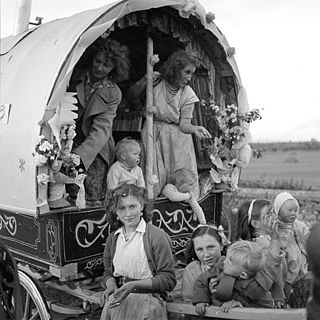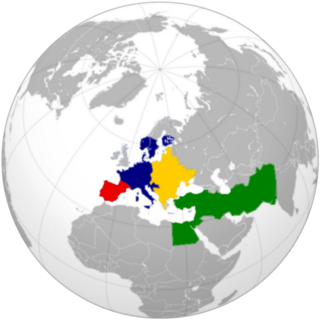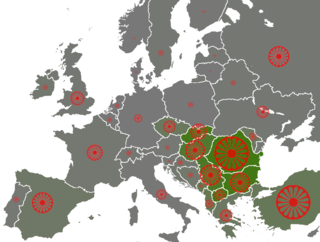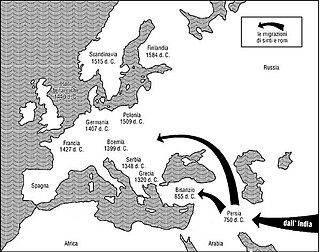
The Romani, also spelled Romany or Rromani and colloquially known as the Roma, are an ethnic group of Indo-Aryan origin who traditionally lived a nomadic, itinerant lifestyle. Linguistic and genetic evidence suggests that the Romani originated in the Indian subcontinent, in particular the region of present-day Rajasthan. Their subsequent westward migration, possibly in waves, is now believed by historians to have occurred around 1000 CE. Their original name is from the Sanskrit word डोम, doma and means a member of the Dom caste of travelling musicians and dancers. The Roma population moved west into the Persian Ghaznavid Empire and later into the Byzantine Empire. The Roma are thought to have arrived in Europe around the 13th to 14th century. Although they are widely dispersed, their most concentrated populations are located in Bulgaria, Hungary, Romania, Spain, and Turkey.

Irish Travellers, also known as Pavees or Mincéirs are a traditionally peripatetic indigenous ethno-cultural group originating in Ireland.

Romani music is the music of the Romani people who have their origins in northern India but today live mostly in Europe.

Romanichals are a Romani subgroup within the United Kingdom and other parts of the English-speaking world. Most Romanichal speak Angloromani, a mixed language that blends Romani vocabulary with English syntax. Romanichals resident in England, Scotland, and Wales are part of the Gypsy, Roma, and Traveller community.

Roma, traditionally Țigani, constitute one of Romania's largest minorities. According to the 2011 census, their number was 621,573 people or 3.3% of the total population, being the second-largest ethnic minority in Romania after Hungarians. There are different estimates about the size of the total population of people with Romani ancestry in Romania, varying from 4.6 per cent to over 10 percent of the population, because many people of Romani descent do not declare themselves Roma. For example, in 2007 the Council of Europe estimated that approximately 1.85 million Roma lived in Romania, based on an average between the lowest estimate and the highest estimate available at the time. This figure is equivalent to 8.32% of the population.

The Kalderash are a subgroup of the Romani people. They were traditionally coppersmiths and metal workers and speak a number of Romani dialects grouped together under the term Kalderash Romani, a sub-group of Vlax Romani.

The Romani people are a distinct ethnic and cultural group of peoples living all across the globe, who share a family of languages and sometimes a traditional nomadic mode of life. Though their exact origins are unclear, central India is a notable point of origin. Their language shares a common origin with, and is similar to, modern-day Gujarati and Rajasthani, borrowing loan words from other languages as they migrated from India. In Europe, even though their culture has been victimized by other cultures, they have still found a way to maintain their heritage and society. Indian elements in Romani culture are almost non-existent, with the exception of their language. Romani culture focuses heavily on family. The Roma traditionally live according to relatively strict moral codes. The ethnic culture of the Romani people who live in central, eastern and southeastern European countries developed through a long, complex process of continuous active interaction with the culture of their surrounding European population.

The Romani flag or the flag of the Roma is the international ethnic flag of the Romani people, historically known as "Gypsies", which form a stateless minority in countries across Eurasia, Africa, the Americas, and Australasia. It was approved by the representatives of various Romani communities at the first and second World Romani Congresses (WRC), in 1971 and 1978. The flag consists of a background of blue and green, representing the heavens and earth, respectively; it also contains a 16-spoke red dharmachakra, or cartwheel, in the center. The latter element stands for the itinerant tradition of the Romani people and is also an homage to the flag of India, added to the flag by scholar Weer Rajendra Rishi. It superseded a number of tribal emblems and banners, several of which evoked claims of Romani descent from the Ancient Egyptians.

The Lyuli, Jughi or Jugi are a branch of the Ghorbati people living in Central Asia, primarily Tajikistan, Uzbekistan, Turkmenistan, Kazakhstan, and southern Kyrgyzstan; also, related groups can be found in Turkey, and the Balkans, Crimea, Southern Russia and Afghanistan. They speak ethnolects of the Persian and Turkic language and practice Sunni Islam. The terms Lyuli and Jugi are considered pejorative. They have a clan organization. Division into sub-clans is also practiced. The Lyuli community is extremely closed towards non-Lyuli.

Anti-Romani sentiment is a form of bigotry which consists of hostility, prejudice, discrimination, racism and xenophobia which is specifically directed at Romani people. Non-Romani itinerant groups in Europe such as the Yenish, Irish and Highland Travellers are frequently given the name "gypsy" and as a result, they are frequently confused with the Romani people. As a result, sentiments which were originally directed at the Romani people are also directed at other traveler groups and they are frequently referred to as "antigypsy" sentiments.
The Finnish Kale are a group of the Romani people who live primarily in Finland and Sweden. Their main languages are Finnish, Swedish and Finnish Romani. Kalo/Kale is the collective name for traveler people in Finland, England and Spain.

The Romani people have several distinct populations, the largest being the Roma and the Calé, who reached Anatolia and the Balkans in the early 12th century, from a migration out of the Indian subcontinent beginning about 1st century – 2nd century AD. They settled in the areas of present-day Turkey, Greece, Serbia, Romania, Croatia, Moldova, Bulgaria, North Macedonia, Hungary, Albania, Kosovo, Bosnia and Herzegovina, Czech Republic, Slovenia and Slovakia, by order of volume, and Spain. From the Balkans, they migrated throughout Europe and, in the nineteenth and later centuries, to the Americas. The Roma population in the United States is estimated at more than one million.
Scottish Travellers, or the people in Scotland loosely termed Romani persons or travellers, consist of a number of diverse, unrelated communities that speak a variety of different languages and dialects that pertain to distinct customs, histories, and traditions.

Muslim Romani people are people who are ethnically Roma and profess Islam. There are many different Roma groups and subgroups that predominantly practice Islam, as well as individual Romani people from other subethnic groups who have accepted Islam. Xoraxane Roma in Balkan Romani language, are non-Vlax Romani people, who adopted Sunni Islam of the Hanafi madhhab at the time of the Ottoman Empire. Some of them are Derviş of Sufism belief, and the biggest Tariqa of Jerrahi is located at the largest Arlije and Gurbeti Muslim Roma settlement in Europe in Šuto Orizari, locally called Shutka in North Macedonia have their own Romani Imam and the Muslim Roma in Šuto Orizari use the Quran in Balkan Romani language. Many Romanlar in Turkey, are members of the Hindiler Tekkesi a Qadiriyya-Tariqa, founded in 1738 by the Indian Muslim Sheykh Seyfullah Efendi El Hindi in Selamsız. Roma Muslims in Turkey and the Balkans are mostly cultural Muslims or nominal Muslims.
Polska Roma are the largest and one of the oldest ethnolinguistic subgroups of Romani people living in Poland. Some Polska Roma also live in North America, Switzerland, Sweden, Great Britain and countries of the European Union. The term "Polska Roma" is both an ethnonym of the group and a term used in the academic literature. As such it is distinct from the terms "Polish Roma" or "Roma in Poland" which better denote the broader Roma population in Poland. Polish ethnographer Jerzy Ficowski, writing in the 1950s and 1960s used the term "Polish Lowlander Gypsies" to refer to the same group, though this terminology is no longer in widespread use.

Romani Americans are Americans who have full or partial Romani ancestry. It is estimated that there are one million Romani people in the United States. Though the Romani population in the United States has largely assimilated into American society, the largest concentrations are in Southern California, the Pacific Northwest, Southwestern United States, Texas, Louisiana, Florida and the Northeast as well as in cities such as Chicago and St. Louis.

There are a number of traditionally itinerant or travelling groups in Europe who are known as Travellers or Gypsies.

The Romani people, also known as the Roma, qualify as an ethnic minority group in Poland of Indo-Aryan origins. The Council of Europe regards the endonym "Roma" more appropriate when referencing the people, and "Romani" when referencing cultural characteristics. The term Cyganie is considered an exonym in Poland.

Romani people have been recorded in the United Kingdom since at least the early 16th century. Records of Romani people in Scotland date to the early 16th century. Romani number around est. 225,000 in the UK. This includes the sizable population of Eastern European Roma, who immigrated into the UK in the late 1990s/early 2000s, and also after EU expansion in 2004. Romani people in the UK are considered part of the Gypsy, Roma and Traveller (GRT) community. Romani people in the UK are predominantly Christian, with 71.8% of English and Welsh Romanies identifying as Christian in the 2021 census compared to 46.2% of the wider population.
Gypsy, Roma and Traveller is an umbrella term used in the United Kingdom to represent several diverse ethnic groups which have a shared history of nomadism. The groups include Gypsies, defined as communities of travelling people who share a Romani heritage, resident in Britain since the 16th century; Ethnic Travellers, the traditional travelling people of Ireland and Scotland; and Roma, who are defined as recent Romani migrants from Eastern Europe. Although these groups' traditional lifestyles involved travel, most GRT people now live in houses or permanent caravan berths.

















